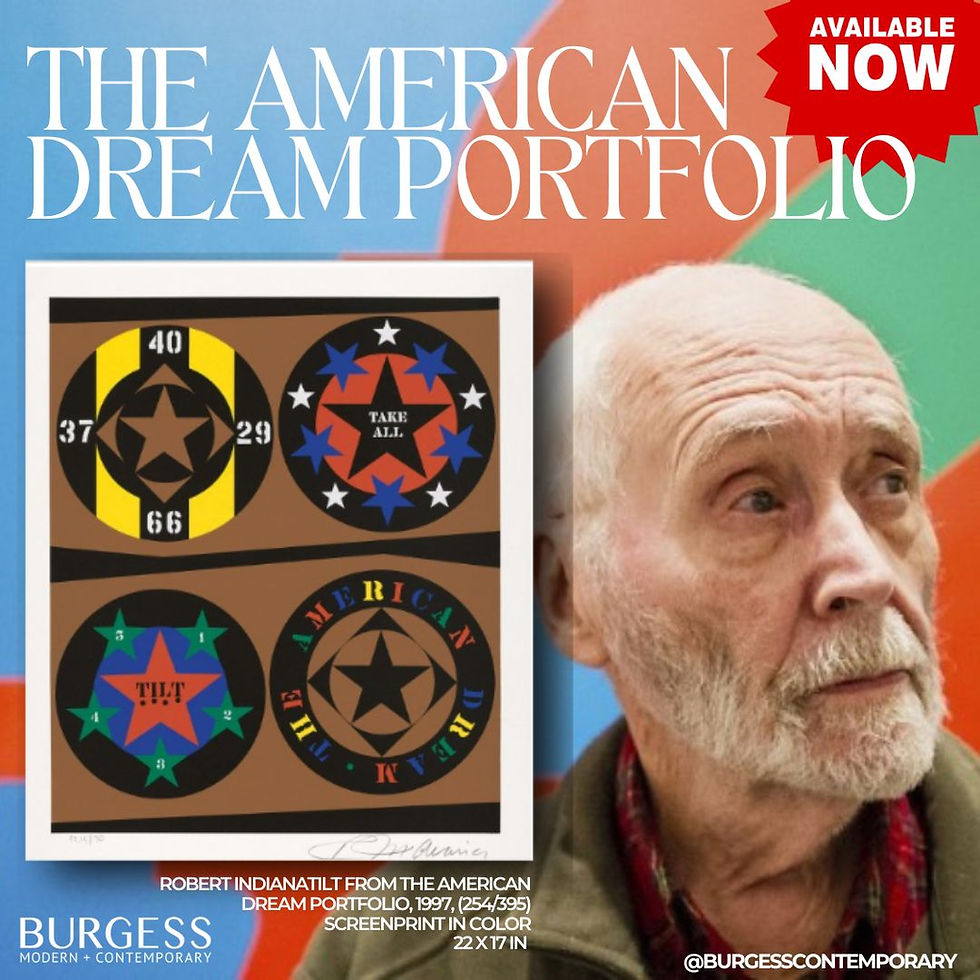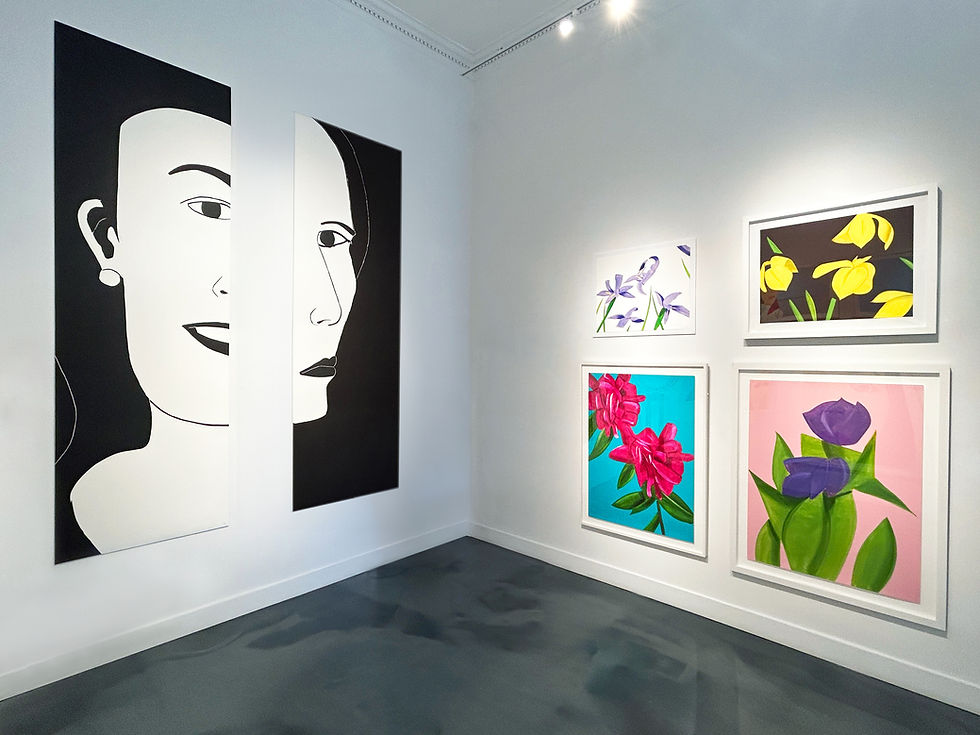BM+C Presents LANGUAGE & INTERPRETATION at Market Art + Design Hamptons 2021
- marketing20994
- Jul 29, 2021
- 7 min read

At Market Art + Design Hamptons Art Fair 2021, Burgess Modern + Contemporary presents a curatorial exhibition titled: LANGUAGE & INTERPRETATION, which includes artwork by Andy Warhol, Jedd Novatt, Damien Hirst, Tom Wesselmann, Eric Fischl, Retna, and Gabriel Delgado. In LANGUAGE & INTERPRETATION, Burgess Modern + Contemporary academically establishes a cumulative selection with artists who conceptually explore academic discourse of dimensional truths, human portrayal, icons, and social events.
From linguistical explorations through the PEMDAS Mathematical Order of Operations to Graffiti Codices, and from Iconic Symbolism to Pop Art propaganda, LANGUAGE & INTERPRETATION instills a sense of elevated scholarly aptitude toward contemporary art discussions. This curated assortment confirms that universal language is understood through a complex analysis of environmental awareness - Posture vs. Perception, Recognition, Decoding, Understanding, Appreciating, and Accepting. Each artist in the exhibit brings a unique style to this silent volubleness.

Eric Fischl’s sublimations on mylar with pins on paper give an artistic approach to the thesis of human portrayals. Fischl explores the psyche of interpretation- of how we see ourselves versus the image we portray to those around us. He emphasizes this in the stacked translucent layers of images. The artworks are interpreted narratives that focus on the characters in the story.
Ever-present is Fischl’s disconnection of the characters in a society that does not support the collective. There is a selfless pose that is contradicted by an external posture. Body language reads louder than the internal dialogue of the mind’s constant chatter of self. In the artwork, how we perceive our own actions might not adequately reflect the reality of a dominant disposition seen by others.

In Men in Water, Fischl’s almost-nude subjects bare large amounts of skin, leaving them vulnerable exposing their core’s truth. In Man Woman and Boy, the ocean breeze flutters the blouse of the woman, while the boy to the left of the composition enjoys an innocent day at the beach. Their relations are unknown creating plots and tales foretold only by the viewing audience, making elaborate connections where none might exist. The audiences’ role connects the subjects in a visual approach while the artist’s physical layers of transparent mylar build physical levels to the storyline.
Andy Warhol’s dichotomy of authority and leadership is most evident in his subject matter, the opposites, Democracy vs. Dictator. By displaying these two together, Burgess Modern + Contemporary reinforces the recognizable pop iconology we have all come to know as Andy Warhol. While we can read into the contexts of each character, the step away from politics is evident through the dis-arming of these portraits through the mechanical means of production.

Andy Warhol’ Mao is based on the official portrait of the Chinese Communist leader Mao Zedong (1893-1976), that was illustrated on the cover of the widely circulated 1966 publication Quotations from Chairman Mao Zedong, also known as the Little Red Book. Party members were strongly encouraged to carry a copy with them as it contained the foundations of Maoist ideology.

Uncle Sam, from Warhols Myths series, can best be summed up by Andy Warhol himself with a famous quote, “Everybody has their own America, and then they have pieces of a fantasy America that they think is out there, but they can’t see,” he says. “You live in your dream America that you’ve custom-made from art and schmaltz and emotions just as much as you live in your real one.”
Internationally acclaimed Contemporary Artist, Jedd Novatt has a visual language that defines his signatory linear aesthetic; an interpretation of factual environmental apexes manifested through lines, angles, and vertices that engage negative space against positive. The artworks theoretically propel themselves through the firmaments of space, carried by the dynamic spatial vibrations found within the arrangements. The momentum is purposefully and perfectly contrasted and even constrained with his choice of rigid and weighted materiality.

Novatt is an artist often examined through constraining connotations of chaos theories. In LANGUAGE & INTERPRETATION, Burgess Modern + Contemporary begins to disseminate and dissect Novatt’s seemingly random elements which are in fact governed by deterministic laws such as gravity.
In the new Hurácan Sculpture Series, Novatt examines discernments of balance with his geometric shapes that build upon, morph within, and volley around each other. It is within these undefined quadrilateral forms that the artist examines the critical analysis of scale and weight. Hurácans’ upward and outward mobilities can be characterized as infinite as the artist probs the perceived absolutes of spatial realities, both physical and transcendental. In this conceptual yet constructed formalism of linear constructs resides Novatt’s self-reliant artistic vocabulary.

In the verisimilitude of our everyday existence, the real definition of the demarcated Kármán Line does not conclude at any given elevation within Earth’s atmosphere, it is merely a subjective definition in man’s rudimentary scientific exploration. In Novatt’s Kármán Line monotypes showcased in this exhibition, the artist interprets conjectures of atmospheric and altitudinal dimensions maneuvering beyond the two-dimensional ocular to a more astomatous reality. As reflective of mankind’s elementary atmospheric assessment, the artist’s visual forms take on the role of what we recognize as a drawing, where linear principles drive the viewer to follow the spontaneous but purposefully arranged composition through calculated routes of intersecting boundaries, edges, configurations, and angles. Through these drawings, Novatt embarks on the colossal and ostensibly unobtainable occupation of relinquishing visual anchors of reference to the viewer for them to understand the conceptual and physical propinquity. The linguistic dichotomy of the two colors renders a flat image, yet the conceptual depth exists in the theoretical planes found between foreground and background and between line and shape.

Heart and Butterfly spin paintings by Damien Hirst are visual excerpts from a public participation venture that Hirst contributed to for the opening of Requiem, a major retrospective of over 100 works which opened on April 25, 2009, at PinkchukArtCentre, Ukraine. During the public opening ceremonies, the artist hosted a spin art workshop, allowing museumgoers to participate in the artmaking process on various shaped paper. Two universally understood symbols, the heart and butterfly, bring a playful sense to his sometimes-offensive visual vocabulary. Stylistically painted in the home-craft, spin art technique, Hirst brings this aesthetic to the blue-chip art world.

Heart and Butterfly both bear the “Hirst” stamped signature, and the accompanying inscription that reads: “This painting was made to celebrate the opening of Damien Hirst, Requiem, at the PinchukArtCentre.”
In Tom Wesselmann’s Still Life with Lilies and Mixed Fruit, and Still Life with Matisse and Johns, two sizable screen-prints on paper that explode with vibrancy, the artist deftly showcases his determination to reject all notions of Abstract Expressionism. These shaped swatches of bold and bright colors provide minimalist environments for everyday objects such as bowls of fruit, flowers, and framed portraits simplistically rendered and void of any emotion. In Still Life with Matisse and Johns he gives accolades to contemporary and modern art masters - Henri Matisse and Jasper Johns. The visual shout-out is more veiled than obvious. The title directs the viewer to decipher the image clues and make the connection to the aspects of Art History.
RETNA was born in Los Angeles, from El Salvadorian, Cherokee, Spaniard and African American bloodlines. This American street artist is known for his unique typography and letterforms where each block of text is a sophisticated system of script, culled from hieroglyphs, calligraphy and illuminated lettering. With influences ranging from Arabic, Egyptian, Hebrew, Old English, and Native American mythologies, RETNA's unique vocabulary communicates a particular narrative. In his cryptic words, letters, and messages, he reflects aspects of a harsh reality of urban life. Yet he is in tune to a sophisticated and metaphysical connectedness that draws inspiration from poignant relevance of historical cannons. RETNA employs ancient totemic symbologies as a baseline, overlaid with rhythms he perceives as compartmentalized sequences of letters to hypothetically vocalize significances deemed important enough to manifest into works of art.

iss 88, a 72 x 72-inch oil and mixed media on canvas painting not only exhibits elements of Retna’s coded alphabet but introduces new contemporary materials and techniques. Colored tape weaved within, above, and under the mark making adds a raised element to the surface while adding notes of audacious decisions.
Gabriel Delgado creates themed artwork that explores aspects of contemporary social and political events, ranging from Police Brutality, Animal Rights, Environmental Rights, Science, Economy, Immigration, Social Reform, and other relevant topics. His PEMDAS driven, and conceptually solvable Order of Operations mathematical equations bring to light the elegance of numerical and text-driven logic via an expressive scientific chalkboard aesthetic.

In X-Press Pearl, a minimalistic conceptual drawing by Delgado details the demise of the Singapore-registered container ship carrying a payload of 378 tons of oil, 25 tons of nitric acid, and 171,000 pounds of low-density plastic pellets. Through his own language of solvable mathematics, he describes the fateful day of May 20, 2021, when the X-Press Pearl caught fire and eventually sank off the coast of Colombo, Sri Lanka. The numerical equation walks the viewer through the catastrophic consequences. Defined, bold and black numbers in the drawing illustrate the disastrous reality of the ongoing environmental catastrophe- 176 turtles, 20 dolphins, 4 whales, and thousands of fish dead. The incident, as described by the media, government sources and the artist, was deemed the worst marine ecological disaster in Sri Lankan history.

Whitewashing introduces an element of pop culture into an otherwise political landscape. Delgado details the controversial narrative of L’Oréal and Elle Australia Magazine’s decision to whitewash Beyonce Knowles’s by digitally lightening her skin for the cover, editorial content, and ads within the publication. The arithmetical calculation illustrates the Editor’s claim that the magazine’s cover does not feature Asians, plus-sized models, pregnant people, models with freckles, red heads, and dark-skinned minorities for fear of reduced sales. Delgado brings to light institutional whitewashing as a form of racism and betrayal of trust against women who see Beyonce as a positive role model.
Burgess Modern + Contemporary’s LANGUAGE & INTERPRETATION presents an exhibition that captures the full attention of the viewer, while creating opportunities to facilitate discussions on a multitude of subjects from academia to politics, and the cosmos to humankind.
For more information on LANGUAGE & INTERPRETATION at Market Art + Design Hamptons 2021, email Marketing Director, Diego Dietrich at marketing@newriverfineart.com or call 954.524.2100




Comments